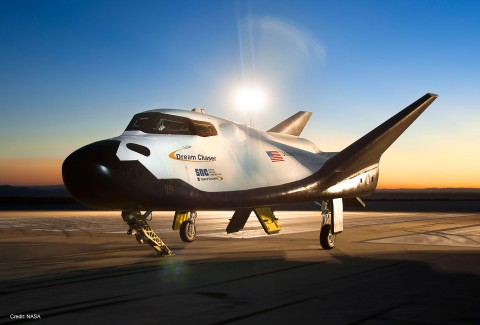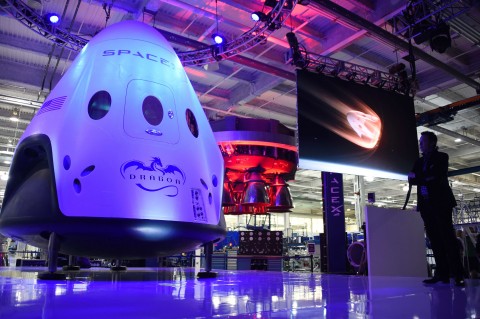http://www.washingtonpost.com/news/business/wp/2014/08/21/the-next-space-race-is-for-a-rental-car-into-orbit/
The next space race is for a rental car into orbit
By Christian Davenport
August 21, 2014
Ever since the retirement of the space shuttle three years ago, American astronauts have had to hitchhike their way to the International Space Station aboard Russian spaceships. It is an increasingly costly arrangement, which the head of NASA has called "unacceptable," made worse by U.S.-Russian tensions over the crisis in Ukraine.
But in the coming weeks, NASA is expected to announce its long-awaited solution: a multibillion-dollar contract to build a U.S. spacecraft, which could help reignite a struggling American space program.
Instead of paying the Russians more than $70 million a seat to ride their Soyuz spacecraft to the space station, the contract would give the United States the ability, for the first time in years, to launch American astronauts into space from U.S. soil.
In a significant shift for an agency that long owned and operated its own rockets, NASA is looking to the private sector to build what would be the equivalent of a rental car for space: a privately owned vehicle that the agency would hire to give its astronauts a ride before returning it -- atmospheric-reentry burn marks and all.
It would inject a large amount of government money into the private space industry and continue NASA's increasing reliance on contractors, which have been flying cargo resupply missions to the space station in recent years. The latest contract could also help expand future competition by elevating smaller, start-up space companies into a realm long dominated by huge, established firms.
NASA hopes the program will have broader implications, with a government subsidy of a corporate enterprise helping to touch off a vast commercial space industry. Foreign governments, scientists and the ultra-wealthy could perhaps also be able to purchase seats on the space ships.
"You can imagine going to destinations other than the ISS," said Michael Lopez-Alegria, the president of the Commercial Spaceflight Federation. There are the commercial space stations being developed, he said, as well as the potential for "hotels and laboratory facilities. There's the potential for a tourism market."
But others are skeptical.
Marco Caceres, the director of space studies for the Teal Group, an aerospace industry analysis firm, said the idea that the contract could spur a commercial market is "wishful thinking" because the demand isn't there yet.
Commercial space flight is "not going to become a booming market for many, many years," he said.
The contract is yet another front in the battles between the new, start-up space companies that are trying to disrupt the industry and the large firms that have been building rockets for decades. The top contenders vying for the NASA contract are what many consider to be two "new-space" companies, SpaceX and Sierra Nevada, and an "old-space" stalwart, Boeing. Blue Origin, Amazon.com and Washington Post owner Jeffrey P. Bezos's company, has also been a partner with NASA in the program.
While the companies' space vehicles have met a series of NASA's milestones, they have yet to prove they can safely fly humans into orbit, which has been achieved only by the governments of the United States, China and Russia (and its predecessor, the Soviet Union). Before any for-profit corporation gets that right, it will have to pass NASA's certification program, which could take years to complete.
Still, the companies, all of which say they can deliver for less than the Russians charge, have made significant progress.
Elon Musk, the billionaire entrepreneur who routinely talks about how humans should become "a multiplanetary species," made waves in the space community when his company, SpaceX, became the first private company to deliver cargo to the space station.
Since then, it has moved aggressively to gain a share of the market to launch national security satellites into orbit. This year, SpaceX sued the Air Force, arguing that it should be able to compete against United Launch Alliance, the space industry Goliath that has had a virtual monopoly on the lucrative national security contract for years.
Musk has also taken aim at the rocket used by ULA, the Atlas V, because it uses a Russian-made engine, and has said that Americans should not be so dependent on the Russians for access to space.
He said the Russians are "massively overcharging" the United States for seats on the Soyuz and has pledged that SpaceX could take astronauts to the space station for "potentially less than $20 million."
ULA, a joint venture between Chicago-based Boeing and Bethesda-based Lockheed Martin, has counterattacked, highlighting its years of experience over SpaceX. In pursuing the contract to send astronauts to the space station, Boeing has also highlighted its long legacy in space.
With a legacy that includes the Apollo, Gemini and Mercury programs, John Mulholland, vice president of commercial programs for Boeing Space Exploration, said Boeing's "experience and expertise" are unmatched.
And while the company has been watching for signs that Russia would cut off sales of the RD-180 engine, he said the company "doesn't think there is going to be any material effect." (Two of the engines were delivered to ULA this week.) Also, Boeing's capsule can fit on many different rockets and does not have to be launched solely on the Atlas V, he said.
While SpaceX and Boeing have developed capsules to take astronauts to space, the third entrant, Sierra Nevada, has developed what is in some ways the most interesting proposal: a "space plane," which looks like a miniature version of the space shuttle and could land on runways.
NASA expects that it would need the space vehicles for about two trips to the ISS a year. That means, the companies hope, there would be opportunities for them to find other customers, which could help offset costs and make the programs even more profitable.
Using a private-sector rocket to transport astronauts marks an evolution for NASA. While the George W. Bush administration started a commercial program, it also invested heavily in what was known as Constellation, which would have replaced the shuttle and funded new missions to the moon.
But the Obama administration killed Constellation, which was over budget and behind schedule, then doubled down on commercial options. Having the private sector design, build and own the space vehicles, under the auspices of NASA, was seen as a way to save time and money and allow NASA to focus on long-term goals, such as sending astronauts to Mars.
Initially, NASA had planned on launching its first astronauts under the commercial crew program by 2015. But budget shortfalls have delayed that until 2017.
In urging Congress to fully fund the program, NASA Administrator Charles Bolden wrote in a blog post last year that "it is unacceptable that we don't currently have an American capability to launch our own astronauts."
SpaceX, the California-based start-up, has argued that its Dragon capsule makes the most sense because it is already used for ferrying cargo to and from the station.
Musk has also promoted the new passenger version of the Dragon as the most advanced option because the reusable capsule can land with helicopter-like precision as opposed to dropping into the ocean.
Sierra Nevada's space plane, called the Dream Chaser, can fly with or without a pilot and can be used at least 30 times. Like the capsules, it would be launched into space atop a rocket. (Sierra Nevada has chosen the Atlas V but says the Dream Chaser could fit on other rockets, as well.)
It can make the return flight in six to 10 hours, said Mark Sirangelo, the head of Sierra Nevada's Space Systems program, and land on any runway that can accommodate a 737 airplane.
And with its compact design, bent wings and race-car-like lines, it is, Sirangelo said, "what an American next-generation space vehicle should look like."
While Boeing trumpets its experience and successful track record, it is also working with new space companies to help it find other customers to take into space. One is Space Adventures, a company based in Vienna, Va., that has helped a few private citizens arrange travel to the space station on Russian Soyuz spacecraft.
Mulholland said that if Boeing won the contract, it would talk to NASA about the possibility of reserving seats for private citizens, which could reduce the government's cost.
It also has partnered with Bigelow, a company that builds inflatable space modules that it intends to lease.
Once the contract is awarded -- and some think it could go to more than one company -- NASA would work to certify the space vehicles, a process that could take a few years.
In the meantime, the United States will have to continue to send its astronauts to the ISS aboard a Russian spacecraft. That gives Russia the power to decide whether American astronauts can get to the space station or not.
Not being able to get there, Caceres said, "would be embarrassing and a huge waste of taxpayer money."
Joel Achenbach contributed to this story.

Sierra Nevada Corporation
Sierra Nevada's "space plane," the Dream Chaser, can fly with or without a pilot.

Robyn Beck/AFP/Getty Images
SpaceX CEO Elon Musk (R) unveils SpaceX's new seven-seat Dragon V2 spacecraft, at a press conference in Hawthorne, California, May 29, 2014. The private spaceflight company's new manned space capsule will ferry NASA astronauts to and from the International Space Station.

